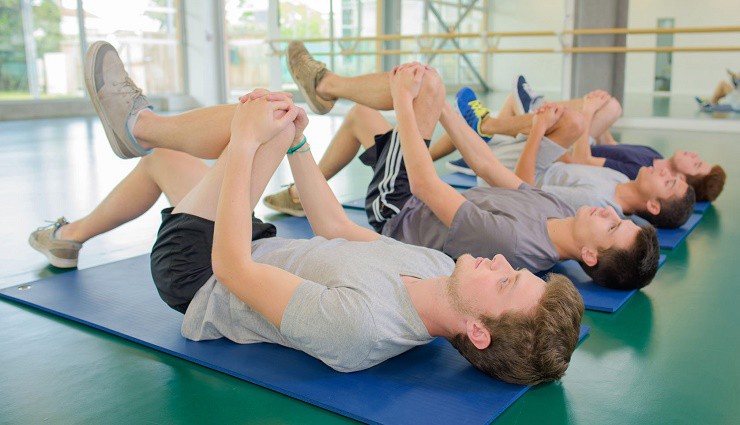Sciatica pain is a nagging pain that, unlike other forms of pain, does not improve with rest. But performing some exercises and stretching movements can help relieve sciatica pain and stiffness in the surrounding area. Although sciatica will resolve over time, these exercises can speed up healing. Next, we will learn about sciatica and its symptoms and ten activities for sciatica pain. Ultimately, we describe why training is practical for sciatica pain and its harmful practices.
What is sciatica?
The sciatic nerve is the longest and thickest nerve in the body. Sciatica starts with five nerves in the lower back that join together to form 1 nerve that runs from the buttocks to the bottom of the legs. Irritation or compression of the sciatic nerve can cause a burning sensation, severe pain in the buttock, or pain that extends down the leg. Usually, this pain occurs only on one side of the body.

The intensity of sciatica pain makes patients think there is a severe problem. But almost 3 out of 4 people recover after a few weeks. More mobility is usually beneficial for the recovery of patients.
Symptoms of sciatica
- moderate to severe pain in the back that sometimes extends to the end of the leg;
- tingling;
- Gazzekardan;
- numb;
- weakness;
- not being able to bend the leg;
- Decreased knee-jerk reflex.
Causes of sciatica pain
Pregnant women are more susceptible to sciatica due to the change in pressure on the spine and pelvis. People with a very high body mass index (BMI) are also prone to this problem, especially from 35 to 50 years old. Heavyweight increases the pressure on the back and pelvis. Sciatica pain may be caused by disc protrusion and pressure on the sciatic nerve. Other causes of sciatica include:
- causing an infection or tumor in the spine or its injury;
- spinal canal stenosis ;
- spondylolisthesis disease ;
- cauda equina syndrome
Ten exercises for sciatica pain
These movements increase strength and flexibility in the gluteal, piriformis, hamstring, and back muscles. You will get the best results by doing these exercises regularly. Of course, all these exercises are not helpful for everyone because sciatica has different causes. Therefore, it is better to consult your doctor before doing these exercises.
Sciatica exercises should cause tension and tension in the area but should not worsen or create new pain.
1. Lying Deep Gluteal Stretch

- Lie on your back and bend your legs. Place the right ankle on the left knee.
- Interlock the fingers of both hands behind the left thigh and slowly pull them towards you. Head and back should stay on the ground.
- Stay in this position for 20 to 30 seconds.
- Repeat the same steps with the other leg.
Place a book or firm pillow under your head to raise it a little. If you can’t easily hold your thigh with your hand, wrap a towel around your thigh and use it to pull your leg towards you. Repeat this movement 2 or 3 times for each leg.
2. Knee to Opposite Shoulder movement

- Lie on your back on the floor and bend your legs.
- Raise your knee and bring it close to the shoulder on the opposite side of the sciatica pain.
3. Knee-to-chest exercise

This simple stretch targets the lower hips and upper thighs.
- Lie on your back on the floor. Bend the legs and place the soles of the feet flat on the floor.
- Bring one of your knees to your chest.
- While pressing the lower back to the floor, stay in this position for 30 seconds.
- Slowly release your leg and repeat the same steps with the other leg.
Do this exercise 2 to 4 times. You can also bring both knees to the chest at the same time.
4. Seated knee-to-chest movement

- Sit on a bed or chair and bring 1 or 2 knees towards the chest.
- Carefully move your knee up and down.
5. Standing Hamstring Stretch

Be careful in doing this exercise. If necessary, lean on something and do not overstretch the muscles.
- Stand straight and place one leg on a surface slightly higher than the other leg but lower than the hip level.
- Straighten your leg and raise your toes.
- While keeping your back straight, lean forward as far as possible without causing discomfort.
- Stay in this position for 20 to 30 seconds.
- Repeat the same steps with the other leg.
- Do this exercise 2 or 3 times for each leg.
6. Pelvic Tilt movement

This exercise strengthens the muscles of the back, hips, and lower abdomen.
- Lie on your back on the floor. Bend the legs and place the hands on the sides of the body.
- By contracting the abdominal muscles, press the lower back to the ground and move the hips and pelvis slightly upwards.
- Release your body after a few seconds.
- Repeat this movement 8 to 12 times.
7. Glute Bridge

The gluteal muscles are a group of muscles in the buttock whose tightening can cause pressure on the sciatic nerve.
- Lie on your back and bend your knees. Legs should be shoulder-width apart, and hands should be placed on both sides of the body.
- Pressing the heels into the floor, raise the hips so that the body forms a straight line from the knees to the shoulders.
- Stay in this position for a few seconds. Then slowly lower your hips.
Proper body shape is essential in this exercise. Do not arch or bend your back. Do this movement in 2 or 3 sets each, including 8 to 10 repetitions.
8. Sitting Pigeon Pose

If you have done yoga, you are probably familiar with this movement.
- Sit on the floor and stretch your legs.
- Bend the right leg and place the right ankle on the left knee.
- Lean forward and slowly lift your upper body towards your thigh.
- Stay in this position for 10 to 20 seconds.
- Release yourself slowly and repeat the same steps with the other side of the body.
9. Sitting trunk stretch

- Sit on the floor and stretch your legs.
- Bend the left knee. Then cross the left leg over the right leg and place it on the outside of the right leg next to the knee.
- Place the right elbow on the outside of the left knee and gently press it into your leg and twist to the left.
- Stay in this position for 20 to 30 seconds. Then do the same steps with the other side of the body.
- Do this movement 2 or 3 times with each side.
10. Child’s Pose

The child’s movement is also one of the popular yoga movements, which includes these steps:
- Kneel on the floor and lower your hips onto your heels.
- Spread your knees hip-width apart and place your torso between your thighs.
- Place your hands on the floor in front of your head.
- Breathe slowly. Do not push the hips into the heels. Placing the hips in this position creates a gentle stretch.
- Stay in this position for 30 seconds.
How does exercise help relieve sciatica pain?
Unlike other forms of injury, sciatica pain improves with exercise, not rest. Continuing to exercise after the pain can also help prevent it from returning. Exercise can reduce sciatica pain by creating effects that we have examined below.
1. Increase muscle strength
Exercise strengthens the muscles of the injured area. Stronger muscles can take some of the weight off the tissues around the injured area. Targeted exercises help to stabilize the back and increase the flexibility of its movements. Therefore, they can effectively reduce the pressure on the discs near the sciatic nerve.
2. Improve blood flow
Exercise improves blood flow in the muscles and nerves in this area. Improving blood flow also helps to transfer oxygen and nutrients to that area and remove toxins and inflammation from it.
3. Improve soft tissue health
Doing regular exercises helps improve the condition of the discs’ soft tissues and keeps them healthy. According to research, the exchange of nutrients and fluids in the spinal discs is better during exercise. Conversely, reduced physical activity can be harmful to discs.
4. Improve nerve health
In a 2016 study, targeted sciatica exercises improved markers of nerve health. By stimulating the nervous system, these exercises increased the flexibility of the nerve and reduced its stiffness and sensitivity.
What exercises should we avoid?
In exercising for sciatica, you should avoid doing exercises that can cause more pain to the sciatic nerve. These exercises can include the following:
- squat movement with weights;
- riding bike;
- High contact movements (High impact);
- Burpee movements;
- Hurdler stretches.
If you feel severe pain or the exercises, increase your pain at any point, stop doing the exercises, and see a doctor.
There are various causes of sciatica. Therefore, there is no one-size-fits-all training program. Never try an exercise that is not suitable for you. Over time, you will be able to perform movements that you were unable to perform at first. Continuing the exercise program is more important than increasing the difficulty of the activities.
you say
Prevention is always better than cure. We can prevent sciatica pain by taking care of your spine and keeping your weight within a healthy range. But if you suffer from this pain, performing the mentioned exercises can help to relieve the pain and recover faster. If you also suffer from sciatica, we would be happy if you shared your experiences with us and wrote about how effective exercise has been for your sciatica pain.
Warning! This article is only for educational purposes; to use it, it is necessary to consult a doctor or specialist.



